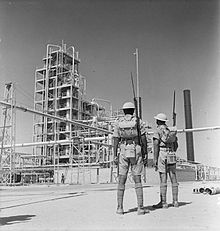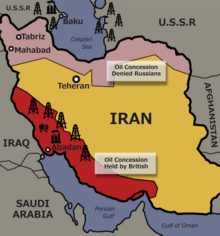Anglo-Soviet invasion of Iran
[5][page needed] Although Reza Shah declared neutrality at an early stage of World War II, Iran assumed greater strategic importance to the British government, which feared that the Abadan Refinery (of the UK-owned Anglo-Iranian Oil Company) might fall into German hands; refining eight million tons of oil in 1940, the refinery made a crucial contribution to the Allied war effort, see Abadan, Iran.[11] In a major strategic analysis in the New York Times on a Sunday following Barbarossa, the famous international correspondent C. L. Sulzberger stated, in reference to the Operation Orient, "It is considered virtually a certainty by military experts that if the Reich succeeds...an attack on Egypt will be launched.Should the Germans...occupy the Caucasus and then push on to Iran and the Persian Gulf they will then outflank the British Middle Eastern positions by a wide sweep and perhaps by Autumn begin to make trouble in Iraq.[19][20] General Archibald Wavell later wrote in his despatch, "it was apparent that the Iranian Government fully expected an early British advance into Khuzestan and that reinforcements, including light and medium tanks, were being sent to Ahvaz".Reza Shah's modernisations had not been completed by the time war broke out,[5][page needed] and the Iranian Army had been more concerned with civilian repression than invasions.[25][26] Iran had bought 100 FT-6 and CKD TNH light tanks as well as some AH-IV tankettes and additional LaFrance TK-6 armoured cars, enough to outfit their 1st and 2nd Divisions.[5][page needed] Reza Shah refused requests by his generals to destroy the road and transportation networks, largely because he did not want to damage the infrastructure that he had painstakingly built during his reign.[5][page needed] The British assembled a naval task force under Commodore Cosmo Graham to seize Bandar Shahpur, Abadan, and Khorramshahr.[31] The naval attack began at 04:10 at Abadan when HMS Shoreham opened fire on the Iranian sloop Palang, sinking it in a single salvo.[31] The Iranians managed to put up a resistance, and the refinery and the city were captured that afternoon after hand-to-hand combat resulted in the deaths of several British and Indian troops.By 29 August, the British had reached the town of Kerend and were within 3 kilometres (2 mi) of Kermanshah and the Iranian commanders were told of the ceasefire order and stood down.It was possible for the Iranian 3rd Division under General Matboodi to move motorised infantry towards Shibli to halt the breakthrough, but due to being taken by surprise, he failed to make the proper counter-attack.[5][page needed] The 53rd Army crossed the border and moved towards the city of Ardabil, defended by Iran's 15th Division led by Brigadier-General Qaderi.General Qaderi's actions, led to the Iranian troops to be left without any reinforcements, which concluded to a fast defeat against the Soviet Army.[5][page needed] On another front, the Soviet Army launched an attack on the village of Alikaran where the Iranian border guards were caught by surprise.[5][page needed] On 25 August, the Soviet attack against Gilan Province began with their Caspian Sea Flotilla, led by Rear-Admiral Sedelnikov.[5][page needed] The Iranian forces sank barges at the entrance to Pahlavi harbour, and lacking coastal artillery, moved a battery of 75 mm guns to the area.In groups of 4 aircraft each, their bombers attacked military positions and civilian targets throughout Gilan, including Bandar Pahlavi and Rasht.The 47th Army had been delayed in the Jolfa area when three individual Iranian soldiers managed to block an important bridge until they ran out of ammunition and were killed.[16] The 47th Army moved south, capturing Dilman (100 kilometres (80 mi) west of Tabriz) and then Urmia (Oromiyeh), ostensibly to block the escape of "German agents".In Tehran itself, the casualties had been light, but the Soviet Air Force dropped leaflets over the city, warning the population of an upcoming massive bombing raid and urging them to surrender before they suffered imminent destruction.[5][page needed][2] Foroughi was an enemy of Reza Shah (he was forced into retirement in earlier years for political reasons, and his son was executed by firing squad).The Persian Corridor became the route for a massive flow of supplies (over 5 million tons of matériel) to the Soviet Union and also the British in the Middle East.At the end of August 1942, German intelligence agents spread leaflets in Tabriz and other cities; an underground fascist organisation called Melnune Iran, was founded.At the Tehran Conference in November of that year, Roosevelt, Winston Churchill and Joseph Stalin reaffirmed their commitment to Iranian independence and territorial integrity, with a willingness to extend economic assistance to Iran.The British and Soviet occupiers used the delivery of grain as a bargaining chip and the food crisis was exacerbated because foreign troops needed to eat and use the transport network to move military equipment.The British meanwhile pressured the Shah to appoint Ahmad Qavam to be the prime minister, who proceeded to mismanage the entire food supply and economy.[7][page needed] In 1943, 30,000 Americans helped to man the Persian Corridor and 26–34 percent of the supplies sent to the Soviet Union under the Lend-Lease Act were sent through Iran.In the middle of 1943, Abwehr's Operation Francois was an attempt to use the dissident Qashqai people in Iran to sabotage British and American supplies bound for the Soviet Union.Also in 1943, Operation Long Jump was, allegedly, an unsuccessful German plot to assassinate the "Big Three" Allied leaders (Stalin, Churchill and Roosevelt) at the Tehran Conference.









Persian campaign (World War I)Mediterranean and Middle East theatre of World War II6th Tank DivisionTabrizReza ShahMohammad Reza PahlaviPersian CorridorAlliesGerman invasionWorld War IISoviet UnionUnited KingdomAustraliaDmitry KozlovSergei TrofimenkoEdward QuinanWilliam SlimAli MansurMohammad Ali ForoughiGholamali BayandorAhmad NakhjavanCaucasusCentral AsiaEuropePolandPolish resistancePhoney WarFinlandWinter WarKareliaLaplandDenmark and NorwayWestern FrontResistanceAlps 1940BritainBalkansSerbian PartisansGreek resistanceEastern FrontChechnyaSicilyAsia-PacificPacific OceanSouth West PacificFranco-Thai WarSouth-East AsiaBurma and IndiaManchuria and Northern Koreapre-war border conflictsMediterranean and Middle EastNorth AfricaLibya-EgyptMorocco-AlgeriaTunisiaEast AfricaMediterranean SeaAdriaticSyria–LebanonDodecaneseSouthern FranceAmericasAntarcticaAtlanticArcticAir WarfareStrategic bombingFrench West AfricaIndian OceanMadagascarUruguayNorwayBaltic NationsYugoslaviaRomania 1941GermanyCroatiaRomania 1944BulgariaHungaryFrench IndochinaMatsueMediterranean and Middle East TheatreGibraltarBahrainBaghdadPalestineItalian mainlandDragoonAlpes-MaritimesneutralImperial State of IranNazi GermanyIran crisis of 1946Kingdom of IraqAzerbaijan SSRTurkmen SSRReza Shah PahlaviAxis invasion of the Soviet UnionAlliedSyria and Lebanonsupply linesoil fieldsTurkeyBritish IndiaPersiaQajar dynastyinfrastructureneutralityPersian Gulfnon-aggression pactNazismAbadan RefineryAnglo-Iranian Oil CompanyD'Arcy ConcessionOperation BarbarossaC. L. SulzbergerOperation OrientWehrmachtTrans-Iranian RailwayLend-LeaseUnited StatesU-boatconvoysArkhangelskTehran